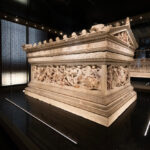LaFarge Mausoleum
Classical
John LaFarge
March 31, 1835 – November 14, 1910
Green-Wood Cemetery
Brooklyn, New York
The mausoleum/vault of American artist John LaFarge (sometimes spelled La Farge) is tucked into a hillside just above Atlantic Avenue. LaFarge was born in New York City. He developed an interest in art during his early schooling (he was doing watercolors at age 6), but was steered toward a career in law. That began to change when he visited Paris where he stated associating with people involved in the arts. Upon his return to the United States, he began executing drawings and landscapes that showed a marked gift for combining color values. He started illustrating books, then moved into murals where he exhibited a vivid sense of composition and color. He was particularly drawn to religious-themed subjects, and was commissioned to do murals for churches in Boston and New York.
Some of LaFarge’s most well known works were those he executed in stained glass. He is credited with first using opalescent glass in stained glass windows, receiving a patent for his process on February 24, 1880. He ushered in what has become known as the “opalescent era” (1880-1920), where glass was produced in multicolored, textured sheets often with an iridescent sheen. Among his stained glass masterpieces are windows at the Trinity Church in Boston, St Paul’s Chapel at Colombia University in New York, First Unitarian Church in Philadelphia, Trinity Episcopal Church in Buffalo, and the Biltmore Estate in Asheville, North Carolina. LaFarge also designed mausoleum windows.
Text and copy © Douglas Keister Visit Doug’s Author Page
[address cemetery=”Green-Wood Cemetery” street=”Willow Avenue” city=”New York” state=”New York” zip=”11218″]

